Urgent Care Patient Satisfaction Benchmark Report
Welcome to the Second Research Findings of the Bi-Annual GMR Web Team Urgent Care Patient Satisfaction Survey 2017 (July-December)
Since the inception of our first patient satisfaction survey report, we have seen some changes in the ways patients review their healthcare visit experience. This survey follows on from our first report, comparing the useful insights on reviews and patient satisfaction. In the first report, we had analyzed data for the first six months of 2017 i.e., January through June 2017. In this second report, we have shown the important trends in online reviews and patient satisfaction for the last six months of 2017 i.e., July through December 2017 by comparing the data with January-June 17.
This survey measures the LOYALTY of patients for their urgent care and helps understand the needs of their patient for developing effective patient related programs to address their pain points. This will help in developing a stronger bond between patient and the facility and the patients will become the advocate of the urgent care center, resulting in more referrals and fueling growth.
Key Takeaways from 2nd Urgent Care Patient Survey:
- 89% of patients gave positive ratings about their visit to urgent care centers, up from 88% in January-June 17
- 6% rated their experience neutral, a decrease of 1% as compared to the previous report
- Overall, the Net Promoter Score, a measure of patient’s loyalty, for urgent care centers is 66.9* (Total Sample = 3930), whereas it was 68.5 in January-June 17
-
- 80% of the patients are Promoters - Loyal enthusiasts who will keep referring other patients, down 1% when compared to January-June 17
- 12% of the patients are Passives - Satisfied but NOT enthusiastic patients who are vulnerable to competitive offerings, whereas it was 13% in the first six months of 2017
- 8% of the patients are Detractors - Unhappy patients who can damage the reputation of urgent care centers and impede growth through negative word of mouth, whereas it was 6% in the first half of 2017
- Sentiment analysis of all patients’ comments about their experience suggested contentment among 82% and trust among 2% of all patients, consistent with their positive ratings.
- Care, Friendly, and Professional were the dominant words used by patients who rated their experience as positive.
*Net Referral Score (a measure of Patient’s Loyalty) = % of Promoters - % of Detractors. Promoters are defined as % of patients who gave a rating of 9 or 10 to their urgent care center and Detractors are defined as % of patients who gave a rating between 0 and 6
Why the Urgent Care Patient Satisfaction Survey Benchmark Report?
Based on our experience of marketing urgent care centers since the inception of GMR Web Team reputation management software RepuGen in 2016, we have noticed a fairly consistent Net Referral Patient score. However, there is a lack of correlation between Net Referral Score and the urgent care online reviews. This could be because unhappy patients are more likely to vent their frustrations online vs satisfied patients posting a positive experience online.
There are four primary goals of this report:
- Compare Patient’s Loyalty for the entire Urgent Care Category vs. our last survey.
- Help individual urgent care centers track their Net Promoter Score vs. the entire category, and use the information for segmented marketing campaign to get patient referrals.
- Identify Patient’s Pain Points, develop patient’s programs to address these pain pains, and track how these initiatives are impacting those pain points.
- Check online review scores to make sure it’s consistent with the average of the urgent care centers used for this survey.
About the GMR Web Team Urgent Care Patient Satisfaction Survey
- An online survey was conducted from July 2017 through December 2017 among 3,930 patients, belonging to urgent care centers that are using the GMR Web Team service. We then compared the findings with the first six months of 2017 (January through June 2017) to show the actual trends.
- The patients were asked to select their likelihood of recommending the urgent care center based on their latest experience on a scale of 0 to 10.
- Patients were asked to explain the reason behind their rating.
- All the information (rating score and comments) was detached from patient and doctor identification to make the report HIPAA compliant. GMR Web Team cannot backtrack comments or sentiments to link Net Promoter Score or sentiment to any patient or urgent care center that were used for this report.
- Patients were then classified into 3 categories – Promoters, Passives, and Detractors
-
- Promoters: Patients giving a rating of either 9 or 10 to their urgent care center were classified as Promoters. They are loyal enthusiasts who will keep referring the urgent care centers to other patients.
- Passives: Patients giving a rating of 7 or 8 to their urgent care center were classified as Passive. They are satisfied but NOT enthusiastic patients who are vulnerable to competitive offerings.
- Detractors: Patients giving a rating of 0 to 6 to their urgent care center were classified as Detractors. They are unhappy patients who can damage the reputation of their urgent care center and impede growth through negative word of mouth
- All comments were grouped by positive, negative, and neutral ratings.
- An established 3rd party artificial intelligence tool was used to gauge patient sentiment by group (positive, negative, neutral) and also to gauge the intensity of the sentiment based on their comments about their experience.
- GMR Web Team proprietary software was used to analyze word density of comments by group for all patients to identify words used by patients to describe their experience.
How Do Patients Rate Their Visit to Urgent Care Center Office Based on Their RepuScore?
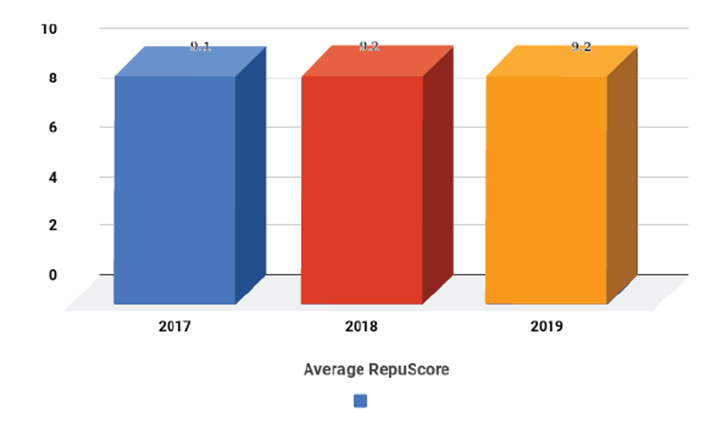
*Repuscore is the score given by patient on a scale of 0 to 10 when asked their likelihood of recommending the urgent care center based on their experience of the last visit. 0 means will not recommend and 10 means will recommend.
Key Findings:
- There was a slight increase of 0.1 in Average RepuScore as compared to the first six months of 2017
Analysis:
Given that the urgent care centers in this study were using GMR Web Team tools to address patient complaints, it is not surprising that the likelihood of recommending the urgent care centers has seen a slight increase above the already high levels of the benchmark study. This also validates our view that paying more attention to patients' experience at urgent care centers is the key to getting more recommendations from patients.
All Ratings (Rating Breakdown)
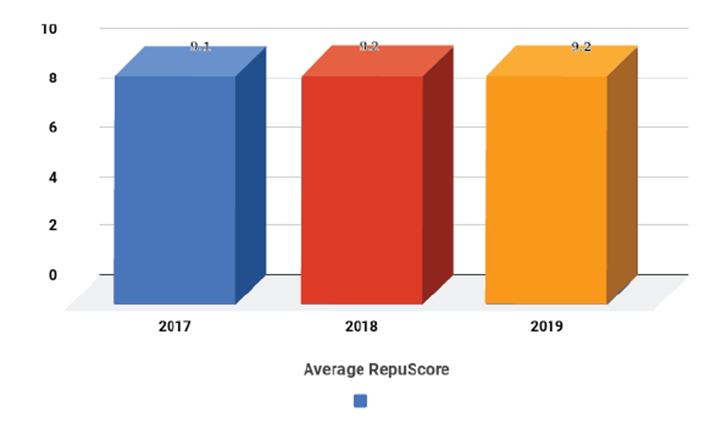
Key Findings:
- Consistent with the overall data, more patients rated their experience as positive
- Patients rating their experience neutral dropped slightly compared to the last survey, whereas ones rating as negative increased slightly
- However, these changes are small and are not statistically significant
Analysis:
The increase in positive ratings suggests that the efforts by urgent care centers to address their patients’ concerns are paying off. A decrease in neutral ratings shows higher percent of patients rating their experience as positive vs. last time. However, the slight increase in negative ratings also shows that some urgent care centers have slipped. Urgent care centers have to compare their individual scores with the overall numbers to identify areas for improving patients experience when they visit their office.
Net Promoter Score Breakdown
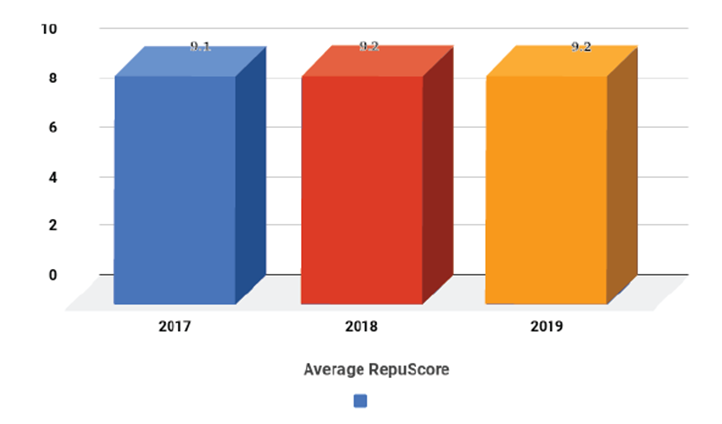
The Net Promoter Score is an index ranging from -100 to 100 that measures the willingness of customers to recommend a company's products or services to others. It is used as a proxy for gauging the customer's overall satisfaction with a company's product or service and the customer's loyalty to the brand.
Key Findings:
- Net Promoter Score saw a decrease of 1.96% point when compared with the first six months of 2017
- Percentage of patients who could become promoters dropped by one percentage point in the latest survey compared to the last one
- 8% of current patients are unhappy about their experience with their urgent care centers, a two percentage point increase from the last survey
Analysis:
The decrease in Net Promoter Score suggests a drop in patients’ happiness with the services at some locations. Overall, 20% of patients are not happy and could leave their current urgent care center in the near future. Urgent care centers need to look at their individual scores and compare with the average number to identify areas where they are doing better and areas where they need to improve.
Patient Sentiment Analysis after their visit:
Patients are asked to explain their reason for rating their visit the way that they did. GMR Web Team analyzes sentiments and its intensity based on the comments, using an artificial intelligence tool.
Customer Emotion Breakdown
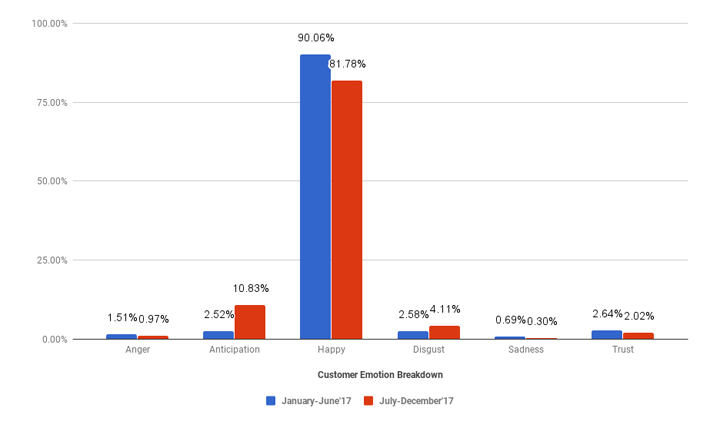
Key Findings:
- Feeling of anticipation increased from 2.52% to 10.83% among the patients
- 81.78% of patients left their urgent care center happy, a drop from 90.06% in January-June 2017
- 2.02% of patients showed trust which decreased by 0.62% when compared to January-June 2017
- 0.97% of patients are angry with their urgent care center which showed a decrease of 0.54% when compared to the first half of 2017
Analysis:
As there is a decrease in the number of happy patients, urgent care centers should make sure to evaluate their scores to identify any potential reason for increased dissatisfaction. Centers should also consider bringing up some programs to increase patient trust, engagement and satisfaction. A slight decrease in angry data is a positive sign for urgent care centers.
Emotional Intensity Analysis (Happy)
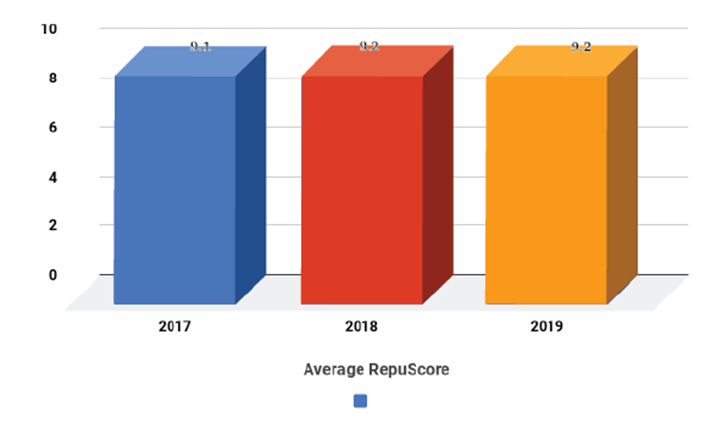
Key Findings:
- 46% of those exhibiting “Happy” emotion showed high intensity, a 2 percentage point increase from the last survey
- 23% of patients showed medium intensity which has decreased by 2.51% when compared to January-June 2017
- The low intensity data remained almost the same, around 31% in January-June 2017 and July-December 2017
Analysis:
Urgent care centers need to identify patients who showed high intensity and launch a campaign to convert them to advocates for the center. There is room for improvement of intensity for urgent care centers for solidifying their relationship with patients.
Emotional Intensity Analysis (Trust)
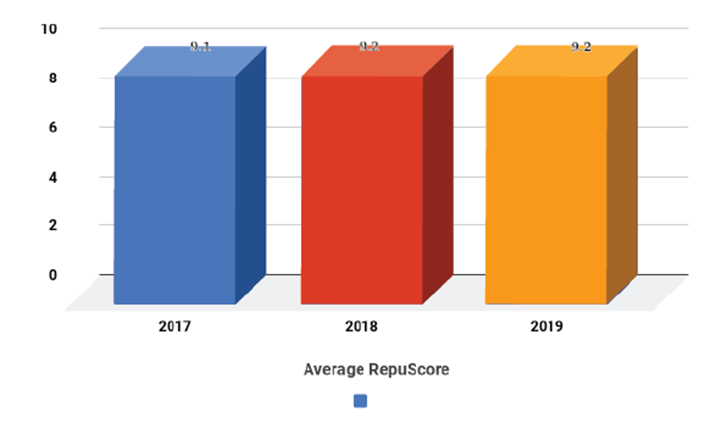
Key Findings:
- Intensity of the majority of the patients showing “Trust” emotion was medium which increased by 6.14% in July-December 2017
- 29.63% of patients showed high intensity trust emotion, whereas it was 26.70% in January-June 2017
- 7.41% of patients showed low intensity which decreased by 9.07% when compared to January-June 2017
Analysis:
Since majority of the patients showed medium intensity, urgent care centers should work on establishing trust between them and their patients.
Emotional Intensity Analysis (Anger)
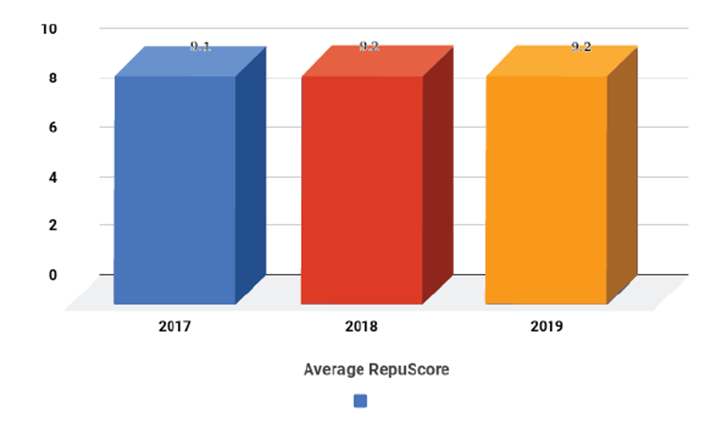
Key Findings:
- Similar to trust emotion, intensity of the majority of the patients showing "Anger" was medium which decreased by 5.57% in July-December 2017 as compared to January-June 2017
- 30.77% of patients showed high intensity, whereas it was 15.52% in January-June 2017
- 23.08% of patients showed low intensity, a decrease of 9.68% when compared to January-June 2017
Analysis:
Again majority of the patients showed medium intensity suggesting improvement in patient recovery. Urgent care centers should handle unhappy patients proactively.
Word Cloud Analysis
Word cloud analysis uses the frequency of words used by patients and picks up the most used words. Size of the word denotes frequency in the chart above.
Positive Ratings -- Top 20
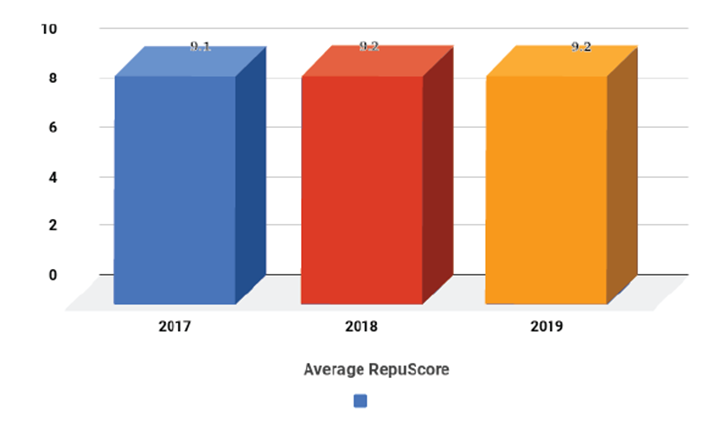
Key Findings:
- Care, Friendly, Professional, Knowledgeable, and Listened were the most used words among patients who rated their visit between 9 and 10.
- Helpful, Knowledgeable, Recommend, Excellent and Nice were some other frequently used words.
Analysis:
Frequently used words by satisfied patients should resonate a positive sentiment, and thus could be used to build expectations for new patients, knowing fully well that it will resonate and that the practice will be able to fulfill the promise. An example could be making a bold statement like Listens, Caring, Friendly, Professional – these are the most used words that patients use to describe their visit.
Negative Ratings – Top 20
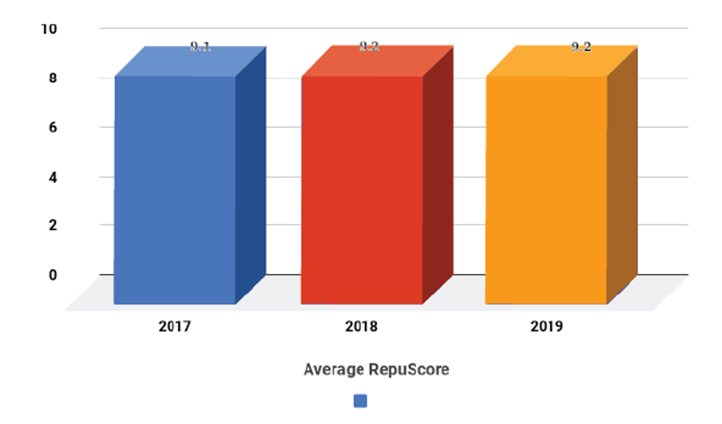
Key Findings:
- Waited is the most frequently word used by unhappy patients.
- Care, Hours, Asked, Prescribed, NP, Terrible and Disappointed are other negative words used by patients.
Analysis:
Frequently used words by unhappy patients allow the urgent care centers to gauge patients’ reasons for dissatisfaction. However, given the fact that the comments of patients were detached, we can assume that the wait time and hours were among the major concerns. These words are more relevant when linked to the patients (which GMR Web Team account holders can do), and also when analyzing the complete review written by the patients.
Why is the Urgent Care Patient Satisfaction Benchmark Report So Important?
Online reviews and recommendations from existing patients are the best source of new patients for urgent care centers. In-depth analyses of patient experience helps urgent care centers identify their strengths and weaknesses, giving them the knowledge to make positive organizational changes.
Understanding the patient sentiment and its intensity provides insight into the patients’ mindsets after they leave the office. Urgent care centers can use the information to improve satisfaction and brand their practice consistent with the positive sentiments generated by their service.
Density of words extracted from patient’s Net Promoter Score of different groups will help communicate the desired branding effort better.
Suggested Next Steps:
Urgent care centers should gather patient experience information to better understand patient sentiment, and ultimately improve patient care and satisfaction.
Patient satisfaction data can also be used to attract more patients by:
- Improving online reputation by requesting happy patients to share their information on the internet. Over 30% of prospective patients select their doctor solely based on their online reviews.
- Developing an automated referral program that requests happy patients to recommend their urgent care center to others.
Contact us at www.gmrwebteam.com to learn how you can start building your patient satisfaction data and how to use it to generate more patients.









